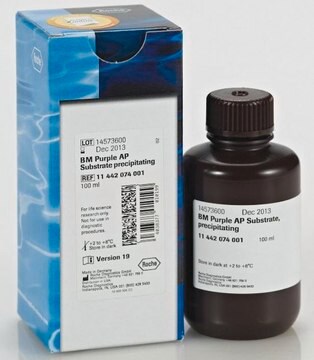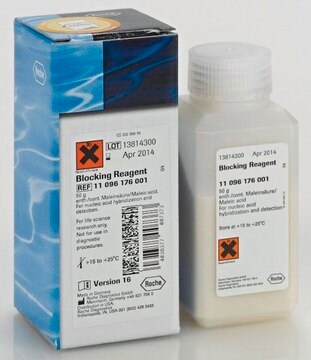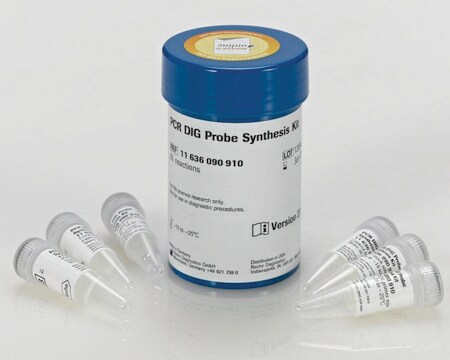Kluczowe dokumenty
11277073910
Roche
DIG RNA Labeling Mix
sufficient for 20 reactions, solution
Synonim(y):
znakowanie kwasów nukleinowych
About This Item
Polecane produkty
Formularz
solution
Poziom jakości
zastosowanie
sufficient for 20 reactions
opakowanie
pkg of 40 μL
producent / nazwa handlowa
Roche
zanieczyszczenia
Ribonuclease, none detected (up to 20 µl using MSII-RNA)
kolor
colorless
rozpuszczalność
water: miscible
temp. przechowywania
−20°C
Opis ogólny
Assay Time: 135 minutes
Sample Materials
Linearized plasmid DNA:
The DNA to be transcribed is cloned into the polylinker site of an appropriate transcription vector which contains adjacent to the polylinker a promoter for SP6, T7 or T3 RNA polymerase. For the synthesis of ‘run off′ transcripts the plasmid is linearized by a restriction enzyme. Restriction enzymes creating 5′-overhangs should be used; 3′ overhangs should be avoided. The linearized template DNA should be purified by phenol chloroform extraction and ethanol precipitation, to avoid RNase contamination. For ′run around′ transcription circular plasmid DNA is used.
PCR product:
PCR-fragments which contain RNA polymerase promoter sequences can also be used as templates for transcription. Purification of the PCR fragment by HighPure column purification prior to transcription is recommended.
Convenient nucleotide mixture for the labeling of RNA with Digoxigenin-11-UTP.
Contents
10x solution with: 10 mM ATP, CTP, GTP (each), 6.5 mM UTP, 3.5 mM DIG-11-UTP.
Specyficzność
Zastosowanie
- Northern blots
- Southern blots
- Dot blots
- Plaque or colony lifts
- RNase protection experiments
- Chromosomes, cells, and tissue sections in situ
Cechy i korzyści
Jakość
Inne uwagi
Hasło ostrzegawcze
Warning
Zwroty wskazujące rodzaj zagrożenia
Zwroty wskazujące środki ostrożności
Klasyfikacja zagrożeń
Acute Tox. 4 Oral
Kod klasy składowania
12 - Non Combustible Liquids
Klasa zagrożenia wodnego (WGK)
WGK 1
Temperatura zapłonu (°F)
does not flash
Temperatura zapłonu (°C)
does not flash
Wybierz jedną z najnowszych wersji:
Masz już ten produkt?
Dokumenty związane z niedawno zakupionymi produktami zostały zamieszczone w Bibliotece dokumentów.
Klienci oglądali również te produkty
Produkty
Digoxigenin (DIG) labeling methods and kits for DNA and RNA DIG probes, random primed DNA labeling, nick translation labeling, 5’ and 3’ oligonucleotide end-labeling.
Metody znakowania digoksygeniną (DIG) i zestawy do sond DNA i RNA DIG, znakowanie DNA z losowym primerem, znakowanie nickiem translacyjnym, znakowanie końcowe oligonukleotydów 5' i 3'.
Protokoły
DIG RNA Labeling Mix Protocol & Troubleshooting
Nasz zespół naukowców ma doświadczenie we wszystkich obszarach badań, w tym w naukach przyrodniczych, materiałoznawstwie, syntezie chemicznej, chromatografii, analityce i wielu innych dziedzinach.
Skontaktuj się z zespołem ds. pomocy technicznej






